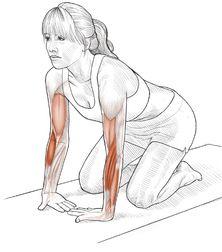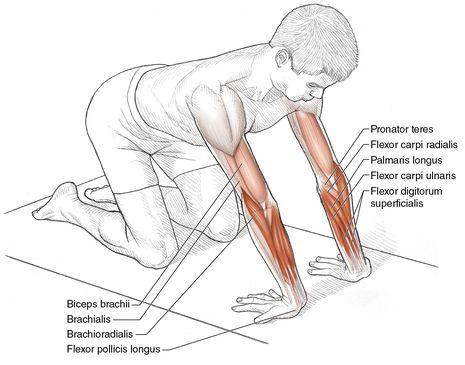Stretching Anatomy-2nd Edition (9 page)
Read Stretching Anatomy-2nd Edition Online
Authors: Arnold Nelson,Jouko Kokkonen
Tags: #Science, #Life Sciences, #Human Anatomy & Physiology

Execution
- Stand upright with your feet shoulder-width apart, toes pointing straight forward.
- In your left hand, grasp a light dumbbell with a weight plate attached to one end only, with the weighted end sticking out past the thumb.
- Stick your left arm out in front of you at shoulder height, with the elbow straight and forearm supinated.
- Pronate the forearm (rotate the wrist toward the little finger) so that the weighted end of the dumbbell points toward the floor.
- Repeat these steps for the opposite arm.
Muscles Stretched
- Most-stretched muscle:
Left supinator - Lesser-stretched muscle:
Left biceps brachii
Stretch Notes
A short and tight (hypertonic) supinator is a major contributor to lateral elbow pain, often called tennis elbow. A severe hypertonic supinator can contribute to either supinator syndrome or radial tunnel syndrome. These syndromes are the result of radial nerve compression and manifest themselves as forearm pain and numbness along with weakness in the lower arm and hand muscles. Movements such as a quick tennis backhand or prolonged forearm supination with a flexed elbow, such as cutting hair, walking a dog on a leash, or carrying heavy boxes from underneath, are the types of movements that can overwork the supinator and lead to a hypertonic muscle.
Be careful not to use a weight that is too heavy. Start with a very light weight plate on one end of the dumbbell, and gradually increase the weight as you become more used to the stretch. In fact, you do not need to use a dumbbell at all. Any object that has a weight on one end of a handle, such as a hammer, will work just as well. Also, this stretch can be done either sitting or standing, with the whole arm lying on a flat surface and the wrist and hand extended past the edge of the surface. If you do use a support, try to keep the shoulder angle near 90 degrees.
Beginner Wrist Extensor Stretch
Execution
- Stand upright with feet shoulder-width apart, toes pointing straight forward.
- Stick your left arm out in front of you at shoulder height, with the elbow straight and forearm pronated.
- Bend the left wrist so that the fingers point toward the floor.
- Place the palm of the right hand against the knuckles of the left hand.
- While keeping the left elbow straight, pull the knuckles toward the body.
- Repeat these steps for the opposite arm.
Muscles Stretched
- Most-stretched muscles:
Left extensor carpi radialis brevis, left extensor carpi radialis longus, left extensor carpi ulnaris, left extensor digitorum communis - Less-stretched muscles:
Left extensor indicis, left extensor pollicis brevis, left extensor pollicis longus, left abductor pollicis longus
Stretch Notes
Tightness in the extensor muscles is a cause of tennis elbow, or pain in the lateral elbow during arm movements. This tightness usually is caused by overworking or straining these muscles. Any activity that uses these muscles, such as keyboard work, racket sports, rowing, weightlifting, wheelchair sports, and rock climbing, can lead to overwork, hypertonicity, and tightness. Also, overworking the extensor pollicis longus and brevis or the abductor pollicis longus can lead to conditions known as drummer boy palsy (mainly the extensor pollicis longus) and intersection syndrome (mainly the extensor pollicis brevis and abductor pollicis longus). By doing this stretch, you help reduce the problems that can arise from overworked wrist extensors.
Intermediate Wrist Extensor Stretch
Execution
- Kneel on the floor.
- Flex both wrists and place the backs of your hands on the floor, hands shoulder-width apart.
- Point the fingers toward the knees.
- While keeping the elbows straight, lean back, bringing the buttocks to the heels, keeping the backs of the hands on the floor.
Muscles Stretched
- Most-stretched muscles:
Brachioradialis, extensor carpi radialis brevis, extensor carpi radialis longus, extensor carpi ulnaris - Less-stretched muscles:
Supinator, brachialis, biceps brachii, extensor digitorum communis, extensor pollicis brevis, extensor pollicis longus, abductor pollicis longus
Stretch Notes
Tightness in the extensor muscles can cause tennis elbow, or pain in the lateral elbow during arm movements. This tightness usually is caused by overworking or straining these muscles. Therefore any activity that uses these muscles, such as keyboard work, racket sports, rowing, weightlifting, wheelchair sports, and rock climbing, can lead to overwork, hypertonicity, and tightness. Overworking the extensor pollicis longus and brevis or the abductor pollicis longus can lead to conditions known as drummer boy palsy (mainly the extensor pollicis longus) and de Quervain syndrome (mainly the extensor pollicis brevis and abductor pollicis longus). The beginner stretch is best for those who have a small range of wrist motion or severe pain when using the wrist. Once you gain more range of motion, however, you should do this intermediate stretch to reduce the problems that can arise from overworked wrist extensors. This stretch will also strengthen the afflicted muscles and start you on the road to prevention of further problems.
The closer the hands are to the knees, the easier it is to keep the backs of the hands touching the floor. The farther the hands are in front of the knees, however, the greater the applied stretch.
VARIATION
Wrist Radial Deviator and Extensor Stretch
By changing the direction that the fingers are pointing, you can change the stretching emphasis on the forearm muscles. For instance, both the wrist extensor muscles and the radial deviator muscles can be stretched simultaneously. First, assume the starting position by kneeling on the floor with the wrists flexed and the backs of your hands on the floor. Second, instead of pointing the fingers toward the knees, rotate the hands so that the fingers point medially (fingertips point toward each other). Finally, stretch the desired muscles by leaning back (buttocks to the heels) while keeping the backs of the hands on the floor.
VARIATION
Wrist Ulnar Deviator and Extensor Stretch
If you change the direction the fingers point, you alter the stretching emphasis on the forearm muscles. To stretch both the wrist extensor muscles and the ulnar deviator muscles simultaneously, first assume the starting position by kneeling on the floor with the wrists flexed and the backs of your hands on the floor. Second, instead of pointing the fingers toward the knees, rotate the hands so the fingers point laterally (fingertips point away from the body on a line perpendicular to the midline of the body). Finally, stretch the desired muscles by leaning back (buttocks to the heels) while keeping the backs of the hands on the floor.
Beginner Wrist Flexor Stretch
Execution
- Stand upright with feet shoulder-width apart, toes pointing straight forward.
- Interlock your fingers, with the palms pointing out away from the body.
- With the arms at shoulder level, straighten your elbows and push your palms out away from the body as far as you can.
Muscles Stretched
- Most-stretched muscles:
Flexor carpi radialis, flexor carpi ulnaris, pronator teres, palmaris longus - Less-stretched muscles:
Flexor pollicis longus, flexor digitorum profundus, flexor digitorum superficialis
Stretch Notes
The flexor muscles easily become tight from repeated use of the arm or wrist in an awkward position or by bending the wrist while typing, using the phone, or operating a machine. Additional problems arise from working with the arm held away from the body or playing sports. This tightness causes pain on the medial elbow, often referred to as golfer’s elbow. The longer a person does any of these activities, the greater the risk of tightness and the greater the need to stretch these muscles.
Intermediate Wrist Flexor Stretch
Other books
Courted by Karma (The Adventures of Anabel Axelrod) by Ellen, Tracy
The Oathbreaker's Shadow by Amy McCulloch
Bonnie of Evidence by Maddy Hunter
A Model Romance (True Love Book 3) by Anne, Betsy
Royal Assassin by Robin Hobb
The Gentleman's Daughter by Vickery, Amanda
You're Not You by Michelle Wildgen
Red Ink (Mad Jackals Brotherhood MC Book 2) by Evelyn Glass
Becoming Holmes by Shane Peacock
Drums of Autumn by Diana Gabaldon






